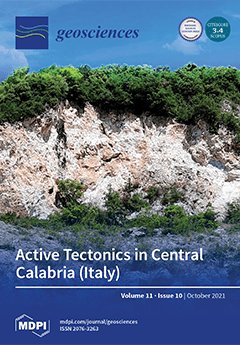Glacial geology, marine environment, and arid climate govern the composition of clay tills. The main purpose of this work is to develop a clear understanding of the engineering behavior of compacted clay till under soil suction and applied stress. The results indicate moderate
[...] Read more.
Glacial geology, marine environment, and arid climate govern the composition of clay tills. The main purpose of this work is to develop a clear understanding of the engineering behavior of compacted clay till under soil suction and applied stress. The results indicate moderate water adsorption due to the presence of clay minerals (26% corrensite, 10% illite, and 8% kaolinite) with Ca
2+ as the dominant cation and a flocculated fabric in a slightly basic (pH = 7.5) pore water. The water retention curve comprised four transition points that are associated with capillary water drainage from large pores (air entry value of 2 kPa and residual suction value of 20 kPa) and small pores (air entry value of 700 kPa and residual suction value of 5 × 10
4 kPa). Beyond the last value, vapor flow is dominant and removes the adsorbed water by evaporation. The ratio of soil volume change to water volume change best described the s-shaped shrinkage path that also comprised four stages, namely: from most large pores with low volume change; from remaining large and most small pores along with almost equal volume change; from some small pores with low volume change; and from the rest of the small pores with no volume change. Likewise, the s-shaped swelling potential curve comprised three stages and correlated well with bimodal hydraulic conductivity curve, that is, slow initial swelling (unsaturated hydraulic conductivity around 10
−14 m/s) due to expansion of peripheral clay in lumps; high primary swelling (unsaturated hydraulic conductivity of up to 10
−11 m/s) due to thickened double layer of most colloids; and slow secondary swelling (albeit unsaturated hydraulic conductivity around 10
−10 m/s) due to expansion of remaining particles. Soil compression (compression index of 0.164) was due to a gradual reduction in number of large pores, whereas rebound (swelling index of 0.047) was due to water adsorption on clay with part of the deformations recovered. Finally, the consolidation rate was related to saturated hydraulic conductivity, which varied by three orders of magnitude.
Full article





